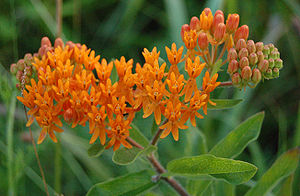Asclepias tuberosa
| Asclepias tuberosa | ||||||||||||
|---|---|---|---|---|---|---|---|---|---|---|---|---|

Asclepias tuberosa |
||||||||||||
| Systematics | ||||||||||||
|
||||||||||||
| Scientific name | ||||||||||||
| Asclepias tuberosa | ||||||||||||
| L. |
Asclepias tuberosa , also called bulbous milkweed or orange milkweed , is a species of the genus silkweed ( Asclepias ) in the subfamily Asclepiadoideae within the family of poisonous plants (Apocynaceae). The wide distribution area extends from eastern Canada to northern Mexico .
description
Vegetative characteristics
Asclepias tuberosa grows as a perennial herbaceous plant and reaches heights of up to about 90 cm. The milky juice is clear. It forms a deep taproot from which one to about 100 strong stems grow every spring. The stems , which only branch out at the inflorescence, are covered with thin, soft or stiff hairs ( trichomes ).
The irregularly, usually alternate arranged on the stem leaves have short, 1 to 5 mm long stems. The thin, firm and occasionally ruffled leaf blade is 3 to 11 cm long and 0.3 to 3.0 cm wide, narrow to wide and lanceolate with a pointed or rounded end. Especially the underside of the leaf is covered with thin hairs.
Generative characteristics
The flowering period extends from May to July. The inflorescence bears few to many, terminal to subterminal, little to many-flowered, umbel-shaped cymoids. The corolla has a diameter of up to 1 cm, depending on how strongly the corolla lobes are bent. The 7 to 8 mm long corolla lobes are strongly bent back and vary in color from yellowish, mostly orange to red. The stalked gynostegium is usually orange, less often yellow. The stem has a length of about 2 mm long and a diameter of about 1.5 mm. The corolla lobes are upright oblong-lanceolate, hood-shaped and 4 to 5 mm long. The horn-shaped secondary process is longer than the tip and curves in over the head of the summit. The stylus head is cylindrical and measures about 2 mm in height and 2 mm in diameter.
The follicles standing upright on a short stem are relatively long and slender with a length of 8 to 15 cm and a diameter of 1.0 to 1.5 cm. Their surface is bare and covered with warts. With a length and width of 5 to 7 mm wide, egg-shaped, flat seeds have a 3 to 4 cm long, white head of hair.
The basic chromosome number is n = 11.
ecology
The pollination is usually performed by large bees and wasps, less often by butterflies. Asclepias tuberosa is an important food plant for the caterpillars of the monarch butterfly ( Danaus plexippus ).
Occurrence
Asclepias tuberosa occurs in almost all continental states of the USA with the exception of Washington, Oregon, Idaho, Nebraska, Montana, North Dakota and Alaska as well as in southeastern Canada (Quebec and Ontario) and northern Mexico.
Asclepias tuberosa is a common wild plant along roads and other human-influenced habitats. It prefers stony, relatively dry soils and sunny locations.
use
Due to its yellow to bright orange-red inflorescences, Asclepias tuberosa is used as an ornamental plant . In Central Europe, however, it usually needs light winter protection.
Medical importance
In the 19th century, plant parts were used for lung problems such as asthma and bronchitis. Asclepias tuberosa is still used as a remedy in homeopathy .
Systematics
The species Asclepias tuberosa is divided into four subspecies by Woodson (1954):
- Asclepias tuberosa subsp. tuberosa : The leaves are typically ovate to lanceolate and wedge-shaped at the base, the edges are usually smooth. Distribution: New Hampshire to northern Florida ( merging there into the subsp.rolfsii ), westwards to the Alleghenies (merging there into the subsp. Interior )
- Asclepias tuberosa subsp. rolfsii (Britton ex Vail) Woodson : The leaves are typically lanceolate with curled edges. Florida to Georgia (there it changes into the subsp.tuberosa ) and westward along the coast of the Gulf from Mexico to Alabama (there it changes into the subsp.tuberosa or subsp. Interior )
- Asclepias tuberosa subsp. interior Woodson : The leaves are typically heart-shaped. Distribution: Ozark plateau eastward to the Alleghenies (there merging into the subsp.tuberosa), southward to the plain of the Gulf of Mexico (there merging into the subsp.rolfsii), and in an arc westward and northward from Texas to in extending north of Michigan (there it goes into the subsp. terminalis ).
- Asclepias tuberosa subsp. terminalis Woodson : The leaves are lanceolate, ovate, oblong to elliptical with smooth margins. At the base they are typically blunt or truncated to heart-shaped. This subspecies occurs on the western edge of the range of the species, from Tamaulipas northwest to southern Utah, and east to Colorado, South Dakota, southern Minnesota, Wisconsin and in the north of Michigan (there in an arc east and south in the subsp. interior passing over). The subspecies terminalis is now better known as a synonym for Asclepias tuberosa subsp. interior Woodson posed.
swell
literature
- Robert E. Woodson, Jr .: The North American Species of Asclepias L. , Annals of the Missouri Botanical Garden , 41 (1), St. Louis, Mo., 1954, pp. 1-211: URL
- Robert Wyatt: The Reproductive Biology of Asclepias tuberosa: I. Flower Number, Arrangement, and Fruit-Set. , In: New Phytologist , 85 (1), Oxford 1980, pp. 119-131: URL
- Robert Wyatt: The Reproductive Biology of Asclepias tuberosa. II. Factors Determining Fruit Set. , In: New Phytologist , 88 (2), Oxford 1981, pp. 375-385: URL
Individual evidence
- ↑ Ontario Wildflowers .
- ^ William Boericke: Handbook of the homeopathic materia Medica , 845 S., Heidelberg, Haug, 1992 ISBN 3-7760-1193-9 .
- ↑ Rafaël Govaerts (ed.): Asclepias. In: World Checklist of Selected Plant Families (WCSP) - The Board of Trustees of the Royal Botanic Gardens, Kew . Retrieved January 3, 2020.



